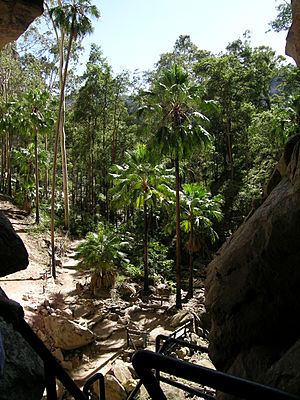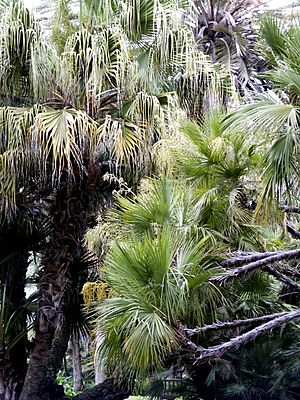Carnarvon Gorge cabbage palm facts for kids
Quick facts for kids Carnarvon Gorge cabbage palm |
|
|---|---|
 |
|
| Scientific classification | |
| Genus: |
Livistona
|
| Species: |
nitida
|
| Synonyms | |
|
Livistona sp. Carnarvon |
|
The Carnarvon Gorge cabbage palm, also known as Livistona nitida, is a type of flowering plant in the palm family (Arecaceae). This special palm tree is found only in Queensland, Australia. It's a unique part of the Australian landscape!
Contents
Meet the Carnarvon Gorge Cabbage Palm
This amazing palm tree can grow very tall, reaching up to 35 meters (about 115 feet) high! That's like a 10-story building. It has a strong trunk with marks from old leaves. The lower part of the trunk keeps some dead leaf stems, but higher up, they fall off, leaving a smooth trunk.
Flowers and Fruits of the Palm
The Carnarvon Gorge cabbage palm has pretty cream to yellow flowers. You can see these flowers from September to December. After the flowers, the palm grows round, glossy black fruits. These fruits appear from November to March. The word nitida in its scientific name means "shining" or "polished," which describes these shiny black seeds perfectly!
This palm is a "dioecious" plant. This means that individual trees are either male or female. Male trees produce pollen, and female trees produce seeds after being pollinated.
Where Does This Palm Live?
You can find Livistona nitida in specific areas of Queensland, Australia. It grows in the river systems of the Dawson, Comet, and Burnett Rivers. It's also very common in the beautiful Carnarvon Gorge.
These palms love to grow near streams and in areas that sometimes flood. But you can also spot them near sandstone cliffs and deep gorges, showing how tough and adaptable they are!
Naming the Carnarvon Palm
The scientific name Livistona nitida has an interesting story. The first part, Livistona, was given to honor Patrick Murray, Baron of Livingston. He helped create the famous botanical gardens in Edinburgh, Scotland.
The second part, nitida, comes from a Latin word meaning "shining" or "polished." This refers to the palm's shiny, glossy black seeds.
This palm was officially described in 1998 by a scientist named Tony Rodd. Before that, people knew it as Livistona sp. Carnarvon.
Images for kids



